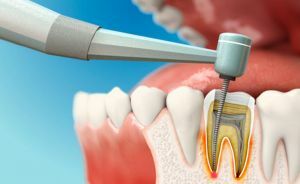 Cleaning the tooth canals( endodontics) is one of the most complicated dental procedures. The main difficulty lies in the fact that the doctor needs to clean the tooth segment, which is practically not visible.
Cleaning the tooth canals( endodontics) is one of the most complicated dental procedures. The main difficulty lies in the fact that the doctor needs to clean the tooth segment, which is practically not visible.
In this regard, the procedure is impossible without an X-ray photograph. To clean channels, special dental instruments are used, which are called files. Outwardly they look like a twisted needle, but they are flexible and durable.
Contents of
- Why do you need to perform the cleaning procedures
- Does it hurt?
- All the stages of the
- process What complications can occur?
- What to do if the tooth
is aching after endodontics Why is it necessary to perform
cleansing procedures? Channels of teeth are cavities located in the roots. They are filled with pulp, that is, a tissue that consists of nerve threads, blood vessels and connective tissue.
If bacteria enter the pulp, an inflammatory process occurs, as a result of which the internal tissues of the tooth die.
Infection of the pulp can occur in the following ways:
- through a place affected by caries( a hole in the tooth);
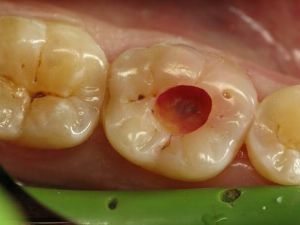
- through a cleft or other mechanical trauma to the tooth;
- through the diseased gingiva( periodontitis).
Inflammation of the pulp is usually accompanied by severe pain, which occurs not only when the tooth is pressed, but also by itself. Also, some patients note increased sensitivity - teeth react painfully to cold, hot, sour and so on.
Only the cleaning of canals can eliminate tissue necrosis and stop the spread of infection.
Remove nerves and clean channels also in the case of prosthetics to avoid infection of the internal tissues of the tooth.
Cleaning the channels allows you to keep a natural tooth. Still about ten years ago at strong development of caries or a pulpitis a tooth deleted.
Does it hurt?
Many people who have to undergo the procedure for cleaning the tooth canals are interested in the question of whether this is painful.
The procedure itself is performed under anesthesia, so the patient does not feel any pain, although some people's testimonies indicate that some discomfort appears.
All the stages of the process
The whole process of cleaning the tooth channels consists of several stages:
- Medical examination and X-ray of the tooth .Dental canals can be of different lengths and have different directions, so the X-ray -
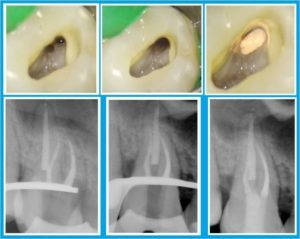 is a mandatory part of the procedure. The snapshot allows the doctor to see where and how the channels are located, which allows him to effectively clean.
is a mandatory part of the procedure. The snapshot allows the doctor to see where and how the channels are located, which allows him to effectively clean. - Anesthesia .Anesthetics are usually administered by injection topically. Anesthesia allows the patient to easily transfer the procedure.
- Insulation of the tooth .Using a special rubber lining, the patient's tooth is isolated. It is necessary that the disinfectant solution does not enter the oral cavity, since it strongly irritates the mucous membrane and can cause a burn. In addition, a rubber pad is needed to prevent saliva from entering the cleaned channels. Saliva contains a large number of bacteria, getting into channels can cause inflammation.
- Open access to channels. The dentist reamers the tooth to open the access to the canals. Usually it is done in a place struck by caries.
- Cleaning channels .With the help of special tools the doctor clears the cavity of the canals. The doctor seems to screw the file into the channel, and then gently extract it. This allows you to remove the affected pulp from the channel. Each time the dentist takes an instrument with a larger diameter. Cleaning is carried out until the channel is cleansed of soft tissues.
- Dry cleaning .After mechanical cleaning, microparticles of pulp and bacteria remain in the channel, so the so-called dry cleaning is used for complete purification. A special chemical compound, which processes the cavity of the tooth and canals, neutralizes microorganisms and dissolves the remains of the pulp. In modern dental clinics, during disinfection uses an ultrasound tool. It creates vortex oscillations in the cavity of the tooth, so that the solution penetrates into the most secluded places.
- Sealing .After dry cleaning, the cavity is well dried. The tooth canals are sealed. For the seal, modern materials are used that do not cause allergic reactions, and also differ reliability and strength. The choice of material in most cases makes the dentist, based on the capabilities of the clinic and the characteristics of the patient. Sometimes, instead of a seal, pins are installed.
- Repeated X-ray .It is necessary that the doctor can make sure that the cavity of the channels is completely sealed. Otherwise, the risk of complications increases. Filling of the tooth .The last step is closing the dental cavity with a seal.
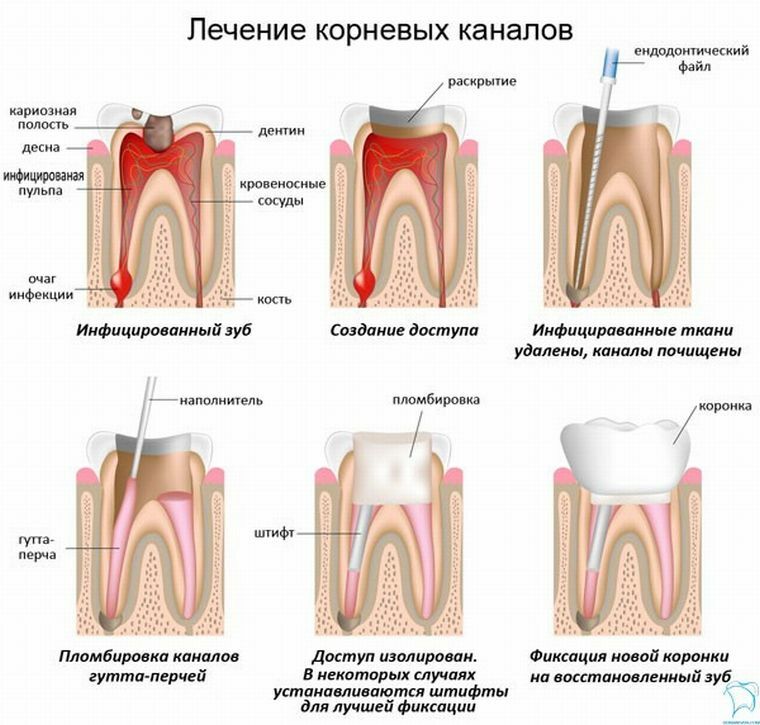
On the photo cleaning of the tooth canals - all the steps step by step
What complications can occur?
Complications when cleaning the root canals are extremely rare. But the procedure does not guarantee complete safety. Sometimes the patient may have:
- severe pain and swelling;
- infection of channels;
- abscess.
Sometimes during the manipulation can not save the tooth( requires removal).
What to do if the tooth is aching after endodontics
 The procedure is painless, but often patients complain that after cleaning the canals they have a toothache. Pain can occur periodically, for example, during bite, or bother constantly.
The procedure is painless, but often patients complain that after cleaning the canals they have a toothache. Pain can occur periodically, for example, during bite, or bother constantly.
Painful sensations arise for several reasons:
- mechanical damage to the tissues of the tooth and soft tissues;
- infection of canals by infection;
- the yield of the filling material from the root of the tooth;
- allergy to the seal;
- damage to the root of the tooth when cleaning.
In the process of endodontics, the tooth and the surrounding roots soft tissues are injured, so the pain appears after the anesthesia has ended. The doctor can prescribe painkillers. In this case, the pain will gradually decrease with each passing day.
If the filling material comes out of the root of the tooth, it will press on soft tissues, creating painful sensations. It is a foreign body, to which the immune system will necessarily react. With allergies or the spread of infection, pain accompanies the swelling and pain of the gums, its redness and soreness with pressure.
The doctor will determine the cause of the pain and eliminate it. Do not take self-medication or take pain medications for a long time, as this can only complicate the situation and lead to the development of serious complications.
To reduce pain and speed up healing of damaged tissues, the following recommendations should be adhered to: 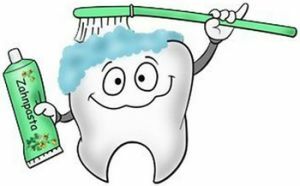
- Do not chew food with a cured tooth for several days;
- gently brush your teeth;
- to abandon bad habits at least for a while;
- to work on strengthening immunity.
Cleaning the root canals allows you to keep a natural tooth. This procedure is lengthy and complex, so it requires a dentist's experience.
Endodontia is performed under anesthesia, so it does not cause pain. But after it can appear painful sensations that most often has natural causes and eventually pass by themselves.
